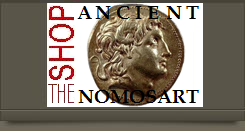
about ancient nomos
Ancient Nomos Art is a museum of galleries exhibiting ancient coins and ancient mint maps. The coin gallery displays the diverse art and history of hand-crafted ancient Greek, Roman, Byzantine, Persian and Medieval coinage. The ancient mints mapping gallery features Greek, Roman, Byzantine, Asia Minor and Medieval mint city regions and territories. Visitor's are welcome to explore, study and enjoy Ancient Nomos Art.

Imperial, Roman – 330 AD
Populi Romanus
From Ancient Galleries

Obverse: Laureate and draped bust of the Genius Populi Romanus facing left holding cornucopiae.
Reverse: Crossed braced bridge between two arched stone towers over flowing river water.
LEGEND
Obv: POP ROMANVS, Laureate and draped bust of the Genius Populi Romanus facing left, with cornucopiae resting over his left shoulder. Rev: Crossed braced bridge between two arched towers over flowing water (Tiber River?); CONS/B.
Constantine is most famous for leading the Empire to Christianity. Before the Battle of the Milvian Bridge, he was apparently quoted as saying the words, “…In Hoc Signo Victor Eris…” (By this sign you shall conquer) on the sun around a Chi Rho ligature. He later added the symbol of Christ on all Roman army shields, since he proclaimed himself victorious in the battle. The Battle of the Milvian Bridge took place between the Roman Emperors Constantine I and Maxentius on 28 October 312. It takes its name from the Milvian Bridge, an important route over the Tiber. Constantine won the battle and started on the path that led him to end the Tetrarchy and become the sole ruler of the Roman Empire. Maxentius drowned in the Tiber during the battle; his body was later taken from the river and decapitated, and his head was paraded through the streets of Rome on the day following the battle. Some say the commemorative coin reverse above depicts the famed Milvian Bridge over the Tiber, where Maxentius made his stand against Constantine’s forces in October of AD 312. Tradition holds that it was prior to this battle that Constantine had a vision that would lead to both his victory over Maxentius and his conversion to Christianity. Others suggest the cross-bracing framework imagery depicts a type of ancient wooden pontoon bridge. The two arched towers at both ends are likely permanent stone structures built into the opposing river banks. Perhaps the reverse imagery actually depicts a type of “temporary” bridge structure route used by Constantine the Great to both protect Rome and enable Soldiers to quickly cross a river at given points. Nevertheless, according to chroniclers such as Eusebius of Caesarea and Lactantius, the Milvian battle marked the beginning of Constantine’s conversion to Christianity. Eusebius of Caesarea recounts that Constantine and his soldiers had a vision of the Christian God promising victory if they daubed the sign of the Chi-Rho, the first two letters of Christ’s name in Greek, on their shields. The Arch of Constantine, erected in celebration of the victory, certainly attributes Constantine’s success to divine intervention; however, the monument does not display any overtly Christian symbolism. This type was part of a special issue struck for the dedication of the new capital at Constantinople.
DOCUMENTATION
Value: ½ Follis. Metal: AE Bronze. Weight: 1.33 grams. Constantinople mint, 2nd Officina. Commemorative series bronze struck in 330 AD to celebrate the founding of Constantinople.
Attribution: Roman Imperial Coinage, VIII 21; Carson, LRBC, London (1978) 1066; David Vagi, CHRE, Sidney. 1999, 3043.
Legend, Documentation and Attribution
